Ganymede – Jupiter’s Giant Moon
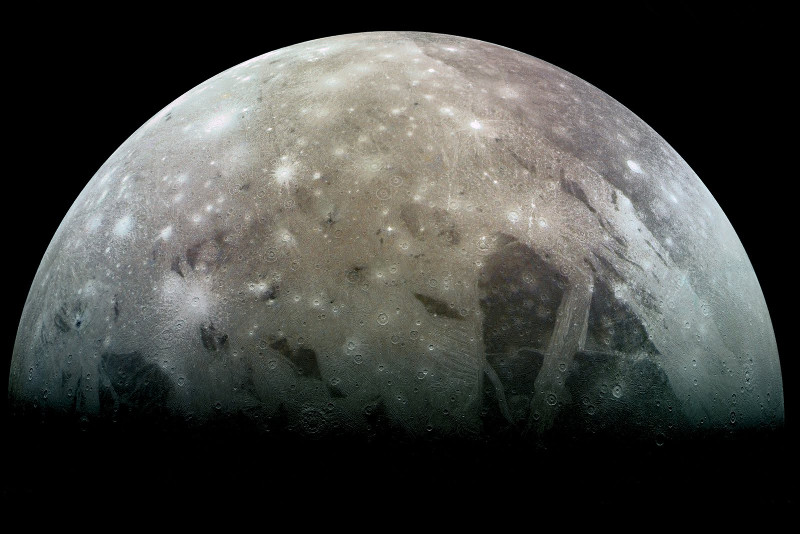
Ganymede shows a mix of new and ancient features on it’s water ice surface (Please click image for a larger version). Credit: JPL/NASA
This continues a series of articles on the moons of Jupiter. The previous articles can be found here:
1. Photographing the Moons of Jupiter
2. Io – The Volcanic Moon of Jupiter
3. Europa - The Ocean Moon of Jupiter
Jupiter’s largest moon Ganymede measures 5270km in diameter, much larger than earth’s moon and larger than the smallest planet Mercury. In fact, in the solar system only Saturn’s moon Titan comes close to Ganymede in size. In many respects it resembles a larger version of Europa with similar surface features and a subsurface water ocean, but the ice layer is thicker and so can sustain some degree of topography such as craters.

Please click image to view the accompanying video of Ganymede to see how it fits into the Jovian moon system
The surface gravity of Ganymede is only 1/6th that of on earth, so assuming sometime in the future can engineer light freely moving spacesuits an astronaut could jump large distances and run very quickly. An athletic person, generating about 1 KW of power who can run 30kmhr or more on earth might be able to run over 70kmhr and jump 4 meters into the sky on this moon! Likewise a record human dead-lift on Ganymede would be close to 3 tonnes.

With a lightweight, free moving, spacesuit an astronaut would be able to run at high speed on Ganymede! Image Credit: NASA
Surface features
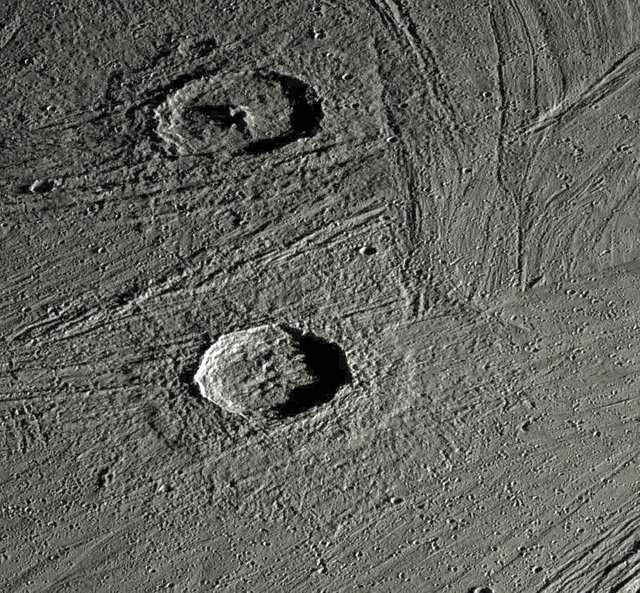
Craters pepper the surface of Ganymede, these ones are quite new and have not had a chance to collapse. Credit: JPL/NASA
There is just a trace of atmosphere of Oxygen around Ganymede, too thin to support any weathering process or life (but enough to allow weak aurora to occur). Fresh impact craters occur across the surface of Ganymede are visible and there appears to be enough strength in the ice crust to at least support the shape of these craters for some period of time. However, older craters, appear to have partly sunken so that just the crater outline is retained as can be seen in the various craters visible in the following image of crater Osiris.
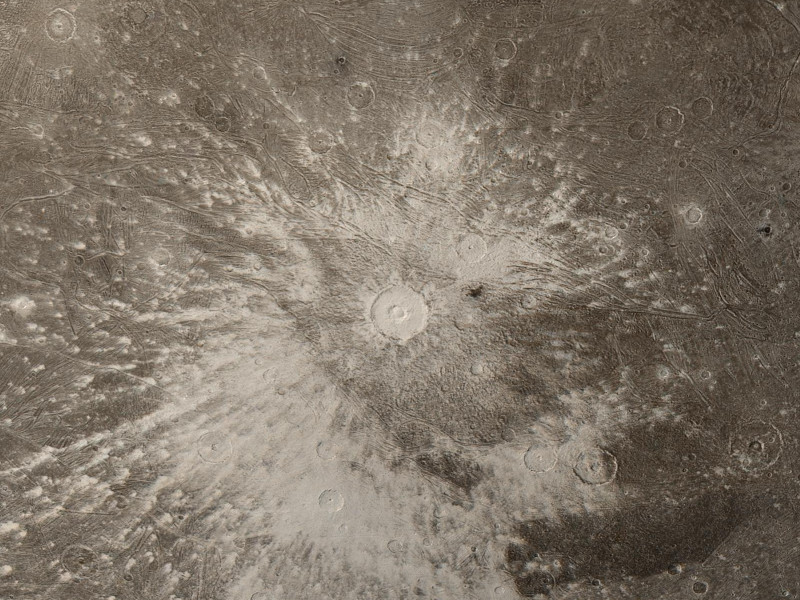
Crater Osiris and it’s ejecta formation. Note how many of the craters appear collapsed. JPL/NASA
The entire surface is covered by lighter and darker areas. The darker areas that cover 30% of the moon are ancient regions that have been contaminated by meteoric impacts over billions of years. In the past there appear to have been periods where the orbit may have been slightly more eccentric causing more tidal heating and stressing that drove plate tectonics. At some places the crust has appeared to have stretched and fractured. The fractures, become infilled with fresher ice.
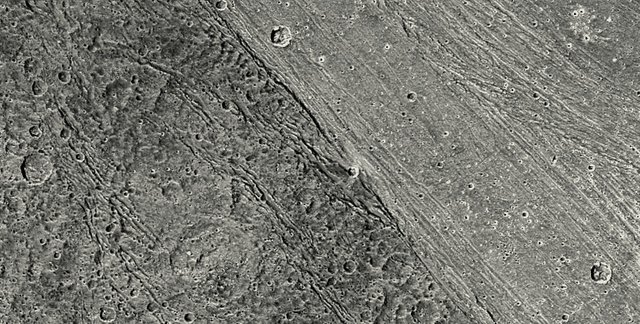
Nicholson Regio (left) is a darker more crater region that interfaces with the smoother younger Harpagia Sulcus (right) . Darker more cratered areas are indicative of older regions. Image Credit: JPL/NASA/DLR
Under the surface
As mentioned in the Europa and Io video’s, Ganymede is in a resonant orbit with these moons contributing to variations in tidal bulges in these moons that in turn cause heating (most prominent in Io). In the case of Ganymede, although some tidal heating is present it is small, but this has not always been the case (judging by past tectonic activity).
Various observation evidence, such as Ganymede Aurora, provide strong evidence of subsurface Ocean. Unlike Europa, however, the ocean does not extend all the way down to the rocky mantle, rather there is a layer of ice outside the core that interfaces with the ocean. For this reason, Europa is more likely to have a better habitat for life as it’s ocean reaches to the rocky mantle, allowing it to mix with minerals that would form life. Some scientists believe there is a complex “club sandwich” type arrangement of different phases of ice and liquid water layers down to the rocky mantle.
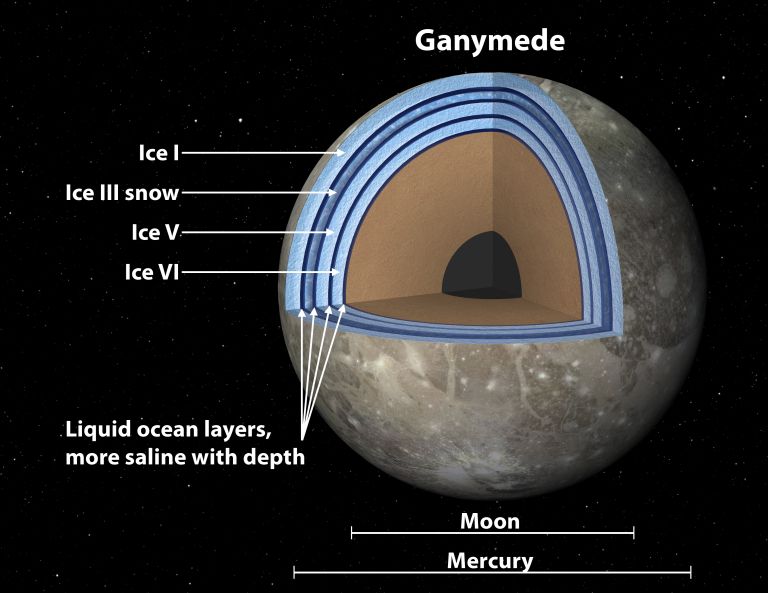
Ganymede "Club Sandwich" artist impression cutaway. JPL/NASA
ESA (European Space Agency) plan to send the JUICE a mission to primarily explore Europa, Ganymede and Callisto arriving 2029. NASA’s Clipper mission arrives at Jupiter around the same but focuses more on Europa, while JUICE will focus on Ganymede.
Observing Ganymede through a Telescope
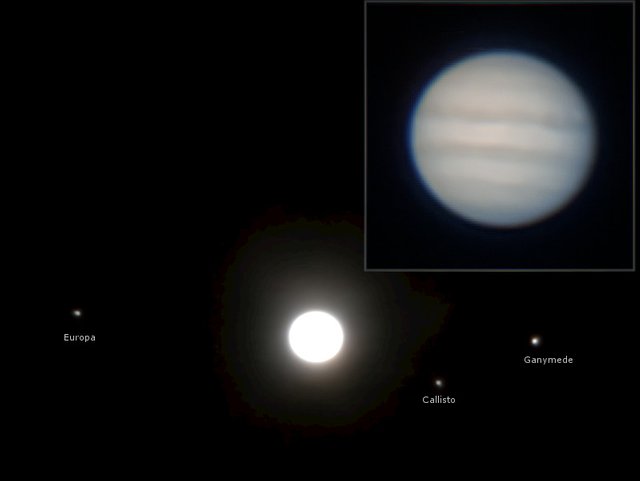
The author’s image of Jupiter and Moons Europa, Callisto and Ganymede was made with an iphone photographing through an 8” telescope. These views are similar to what is seen at the eyepiece
Ganymede is bright enough and orbit’s far enough from Jupiter than it can be easily seen even in binoculars. Although the discovery of Ganymede is generally credited to Galileo in 1610, there are some possible earlier observations with the naked eye. If Ganymede were not adjacent to brilliant Jupiter it would be easy to see with the naked eye as a faint star. The proximity to Jupiter makes it an ultimate test for excellent vision.
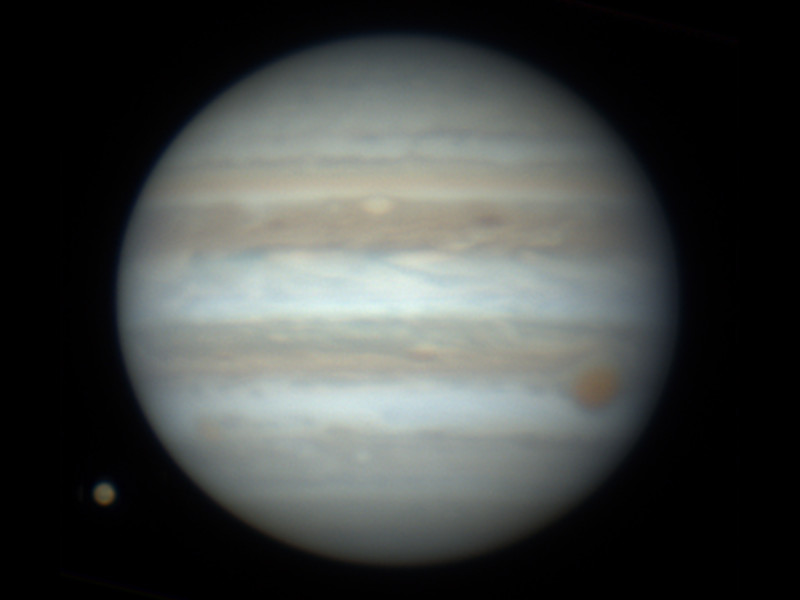
Ganymede appears next to Jupiter in this image made by the author with a 14" telescope.
In a telescope Ganymede at moderate magnification looks like a tiny disk, noticeably larger than stars of similar brightness. It appears from earth similar in size to the planet Neptune (Neptune is much larger, but is also much further away). With an excellent quality large amateur telescope, it is sometimes possible to make out hints of surface detail on the moon. Amateur astronomers with access to specialized cameras and optimized telescopes regularly make images of surface details.
Conclusions
Ganymede resembles Europa in many ways and appears to share similar geological processes (more so in the past than now). We look forward to seeing what result’s ESA’s JUICE and NASA's Clipper missions return in a decade’s time .
In the next article I will look at the final large moon of Jupiter, Callisto.
References
Emily Lakdawalla. An internal ocean on Ganymede: Hooray for consistency with previous results! http://www.planetary.org/blogs/emily-lakdawalla/2015/03121716-ganymede-ocean.html
Emily Lakdawalla. LPSC 2013: License to Chill (or, the solar system's icy moons). http://www.planetary.org/blogs/emily-lakdawalla/2013/03261432-lpsc-2013-license-to-chill.html
Possible "Moonwich" of Ice and Oceans on Ganymede (Artist's Concept) https://photojournal.jpl.nasa.gov/catalog/PIA18005
PIA02577: Bright-Dark Terrain Boundary, Ganymede . https://photojournal.jpl.nasa.gov/catalog/PIA02577
This is a test comment, notify @kryzsec on discord if there are any errors please.
Being A SteemStem Member
Excellent job as always. I had forgotten that Ganymede likely has a subsurface ocean as well - it would be amazing to get some sort of submersible machine down there. Such a huge place and yet no landers planned for it!
How much more detail could you theoretically get on Ganymede with your telescope and ideal conditions?
It seems like Callisto may also have a subsurface ocean too.
At it's largest Ganymede has a diameter of 1.8 arc seconds. Under ideal conditions my 14" telescope can resolve details down to 0.3 arc sec so at best just the broad details. One group of amateurs has started using 1m (40") class telescopes. A recent image I saw from them had perhaps half the resolution of hubble telescope images. Btw here is what hubble is capable of.
Those pictures really aren't bad at all considering the scale - I can see quite a few details on all four moons.
Looking forward to your assumed next post on Callisto!
I think it MIGHT be possible for advanced amateurs to do continuous monitoring of the Satellites and perhaps monitor for activity, like water releases from Europa, Eruptions from Io, etc. You may not necessarily have resolution to see the event directly but using a spectroscope look for the relevant signatures.
Amazing post as always ;)
Thank you @asgarth
Wow if only we could teleport there to explore! Just beautiful.
indeed!
Hi, I found some acronyms/abbreviations in this post. This is how they expand:
....Nope
Wow..what an amazing